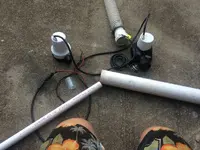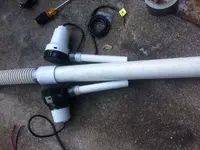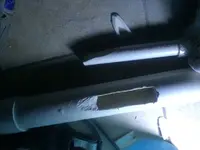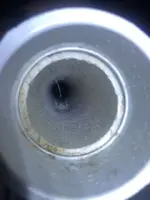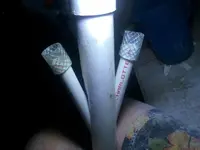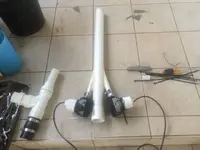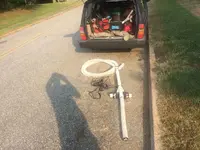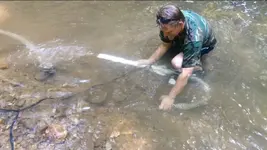You are using an out of date browser. It may not display this or other websites correctly.
You should upgrade or use an alternative browser.
You should upgrade or use an alternative browser.
DIY 2" 12v electric dredge with 2 pumps 1000 gph each other
- Thread starter djpitr
- Start date
KevinInColorado
Gold Member
- Joined
- Jan 9, 2012
- Messages
- 7,044
- Reaction score
- 11,399
- Golden Thread
- 0
- Location
- Summit County, Colorado
- Detector(s) used
- Minelab Gold Monster 1000, Grizzly Goldtrap Explorer & Motherlode, Gold Cube with trommel or Banker on top, Dream Mat combo sluice, Angus Mackirk Expedition, Gold-n-Sand Xtream Hand pump
- Primary Interest:
- Prospecting
Seems like a great idea...looking forward to seeing how much suction you can generate. Keep the hose running to the sluice as short as practical for max suction.
fowledup
Silver Member
- Joined
- Jul 21, 2013
- Messages
- 2,757
- Reaction score
- 5,163
- Golden Thread
- 0
- Location
- Northern California
- Detector(s) used
- Whites GMT V/SAT
- Primary Interest:
- Prospecting
Very cool! Ninja Dredge! Looking forward to a video of it running!
djpitr
Full Member
- #5
Thread Owner
And it was not very good , compare to my 1.5" one pump dredge this one did not suck like i thought it would , i will change the jets little , when i looked inside of the pipe it looked like the whole 2" pipe was full of water just from the pumps , no room much for the water that should be sucked ,
djpitr
Full Member
- #7
Thread Owner
Maybe reducing the intake down some will give you more vacum. Keep tweeking with it, I'm rooting for you.
I will try that Duckshot , my main think is i want to be able suck gravels with 2" hose ,
Im thinking i could put 12v dc motor speed controller to easy regulate pumps flow
And mayby offset the jets couple of inches so they dont effect each others jet streams
Goldwasher
Gold Member
- Joined
- May 26, 2009
- Messages
- 6,084
- Reaction score
- 13,254
- Golden Thread
- 1
- Location
- Sailor Flat, Ca.
- 🥇 Banner finds
- 1
- Detector(s) used
- SDC2300, Gold Bug 2 Burlap, fish oil, .35 gallons of water per minute.
- Primary Interest:
- All Treasure Hunting
problem is Bilge pumps are never going to move much in the upwards direction..They are designed to remove water from an almost level situation.The aren't designed to generate pressure. Necking them down makes them less efficient....hose length does the same.
Time and again someone makes a cool garage recirc...with pump close to discharge an short hose length.
" Nice, I'm gonna make a ninja hi-banker"...then you hit the field your pump ends up 5 feet below the discharge ant 8 feet away in the water.....and your 1000 gph pump is now around 400.
To run well and worthwhile a power sluice 10 inches wide with Hungarian riffles needs at least 40gpm...so a solid 2400gph....hopefully a pump rated for at least 3000 gph so you don't have to run at full throttle.
Try to create the pressure your gonna need for a 2 inch dredge and electric battery power starts to get really difficult with a bilge pump. Even a 3700 gph bilge pump will struggle.....Submersible Bilge Pump, 3700 GPH
I am not knocking the effort or desire to build....I would LOOOOOOVVVVEEEEE a small quiet electric dredge......there is a reason they aren't commercially available....and why a 12v hi-banker is never seen for production......
NOTE before I get jumped on...anything that you have to classify to 1/4 for use is not considered " production" IMHO
a production banker eats buckets and shovels full of un classified.
Time and again someone makes a cool garage recirc...with pump close to discharge an short hose length.
" Nice, I'm gonna make a ninja hi-banker"...then you hit the field your pump ends up 5 feet below the discharge ant 8 feet away in the water.....and your 1000 gph pump is now around 400.
To run well and worthwhile a power sluice 10 inches wide with Hungarian riffles needs at least 40gpm...so a solid 2400gph....hopefully a pump rated for at least 3000 gph so you don't have to run at full throttle.
Try to create the pressure your gonna need for a 2 inch dredge and electric battery power starts to get really difficult with a bilge pump. Even a 3700 gph bilge pump will struggle.....Submersible Bilge Pump, 3700 GPH
I am not knocking the effort or desire to build....I would LOOOOOOVVVVEEEEE a small quiet electric dredge......there is a reason they aren't commercially available....and why a 12v hi-banker is never seen for production......
NOTE before I get jumped on...anything that you have to classify to 1/4 for use is not considered " production" IMHO
a production banker eats buckets and shovels full of un classified.
russau
Gold Member
- Joined
- May 29, 2005
- Messages
- 7,939
- Reaction score
- 7,896
- Golden Thread
- 0
- Location
- St. Louis, missouri
the more you neck down the your outlet line into the venture the more load youll put on to the motor. and if not monitoring the load you could shorten its life or just burn it up! so keep a eye on its amps! nice idea though!
djpitr
Full Member
- #10
Thread Owner
problem is Bilge pumps are never going to move much in the upwards direction..They are designed to remove water from an almost level situation.The aren't designed to generate pressure. Necking them down makes them less efficient....hose length does the same.
Time and again someone makes a cool garage recirc...with pump close to discharge an short hose length.
" Nice, I'm gonna make a ninja hi-banker"...then you hit the field your pump ends up 5 feet below the discharge ant 8 feet away in the water.....and your 1000 gph pump is now around 400.
To run well and worthwhile a power sluice 10 inches wide with Hungarian riffles needs at least 40gpm...so a solid 2400gph....hopefully a pump rated for at least 3000 gph so you don't have to run at full throttle.
Try to create the pressure your gonna need for a 2 inch dredge and electric battery power starts to get really difficult with a bilge pump. Even a 3700 gph bilge pump will struggle.....Submersible Bilge Pump, 3700 GPH
I am not knocking the effort or desire to build....I would LOOOOOOVVVVEEEEE a small quiet electric dredge......there is a reason they aren't commercially available....and why a 12v hi-banker is never seen for production......
NOTE before I get jumped on...anything that you have to classify to 1/4 for use is not considered " production" IMHO
a production banker eats buckets and shovels full of un classified.
Thank you Goldwasher
I play with the 12 v pumps last year and learn all you pointing out .
I have video on youtube of 1.5 inch nozzle with one of these 1000gph bilge pumps that i build and it works very well
I m not trying bring the gravels out of water very high , just 1 inch its fine , so it can br blown on sluice or bazooka trap .
This was my first test of this diferent design , i know if i spray nice stream of water in 2" pipe from this bilge pump and the stream is in the mittle of the pipe it transfers all the energy of the stream of water to the water around it .
So i think its not much about pressure .
I just wanna build most efficient way "MOVE" water that will create suction and take the gravels with it .
djpitr
Full Member
- #11
Thread Owner
the more you neck down the your outlet line into the venture the more load youll put on to the motor. and if not monitoring the load you could shorten its life or just burn it up! so keep a eye on its amps! nice idea though!
Thank you russau
I will put amp meter before the pumps , so i could see how manny amps is it pulling in real time , great idea to know if the load changes much .
And to know exactly how long would battery last .
russau
Gold Member
- Joined
- May 29, 2005
- Messages
- 7,939
- Reaction score
- 7,896
- Golden Thread
- 0
- Location
- St. Louis, missouri
Thank you russau
I will put amp meter before the pumps , so i could see how manny amps is it pulling in real time , great idea to know if the load changes much .
And to know exactly how long would battery last .
in electricity there is a law called the " inverse reciprocal law" that states that when the voltage goes down (low batteries) the current goes up. I know that when I dredged , I kept at it until I run out of gas or the engine does. running Dc voltage you maynot see this happen , BUT you stateing that your going to install a amp gauge would help eliminate that potential problem. good luck!
Timberdoodle
Sr. Member
- Joined
- Oct 17, 2012
- Messages
- 316
- Reaction score
- 243
- Golden Thread
- 0
- Location
- Kingfield, Maine
- Primary Interest:
- All Treasure Hunting
I believe the 3/4" inputs are too large for the given volume of each pump to build pressure. Try the same size jetting for each side that you used for your 1.5" jet. A 2" jet is only a little bigger than twice the total area of a 1.5" jet, so making 2 jets of the same orifice size as the 1.5' jet should provide similar results.
You can use inserts like on your 1.5" jet or heat a short area of the pipe with a heat gun and use a hose clamp and a dowel guide inside to create a short length of restriction. Good Luck!
You can use inserts like on your 1.5" jet or heat a short area of the pipe with a heat gun and use a hose clamp and a dowel guide inside to create a short length of restriction. Good Luck!
NeoTokyo
Bronze Member
I have a 2.5" power nozzle and I strapped 2 of the HF 1000gph pumps on, they were overvolted to 19.2v and really had great suction.
I was running a T also to connect the two, far from optimal.
I ran them overvolted while testing for about 5 minutes with no signs of problems from the pumps.
I was just running a craftsman cordless drill battery.
I have ran a single 12v 1kgph pump off a power wheels 12v battery for hours before though.
I was running a T also to connect the two, far from optimal.
I ran them overvolted while testing for about 5 minutes with no signs of problems from the pumps.
I was just running a craftsman cordless drill battery.
I have ran a single 12v 1kgph pump off a power wheels 12v battery for hours before though.
djpitr
Full Member
- #15
Thread Owner
I believe the 3/4" inputs are too large for the given volume of each pump to build pressure. Try the same size jetting for each side that you used for your 1.5" jet. A 2" jet is only a little bigger than twice the total area of a 1.5" jet, so making 2 jets of the same orifice size as the 1.5' jet should provide similar results.
You can use inserts like on your 1.5" jet or heat a short area of the pipe with a heat gun and use a hose clamp and a dowel guide inside to create a short length of restriction. Good Luck!
Yes timberdoodle , thats what im doing today , i just tough i would test it with 3/4 inch first ,
djpitr
Full Member
- #16
Thread Owner
I have a 2.5" power nozzle and I strapped 2 of the HF 1000gph pumps on, they were overvolted to 19.2v and really had great suction.
I was running a T also to connect the two, far from optimal.
I ran them overvolted while testing for about 5 minutes with no signs of problems from the pumps.
I was just running a craftsman cordless drill battery.
I have ran a single 12v 1kgph pump off a power wheels 12v battery for hours before though.
Great idea NeoTokyo
I ordered 12amp DC-DC step up 12-48 volt power module and volt and amp meter so i will by able regulate the voltage to the pumps form the 12 v battery
 great idea to overclock the voltage to get little more power out of this pumps , i believe 19-20 volt should be ok with them .
great idea to overclock the voltage to get little more power out of this pumps , i believe 19-20 volt should be ok with them .Goodyguy
Gold Member
- Joined
- Mar 10, 2007
- Messages
- 6,489
- Reaction score
- 6,913
- Golden Thread
- 0
- Location
- Arizona
- Detector(s) used
- Whites TM 808, Whites GMT, Tesoro Lobo Super Traq, Fisher Gold Bug 2, Suction Dredges, Trommels, Gold Vacs, High Bankers, Fluid bed Gold Traps, Rock Crushers, Sluices, Dry Washers, Miller Tables, Rp4
- Primary Interest:
- All Treasure Hunting
Thank you Goldwasher
I play with the 12 v pumps last year and learn all you pointing out .
I have video on youtube of 1.5 inch nozzle with one of these 1000gph bilge pumps that i build and it works very well
I m not trying to bring the gravels out of water very high , just 1 inch its fine , so it can be blown on sluice or bazooka trap .
This was my first test of this different design , i know if i spray nice stream of water in 2" pipe from this bilge pump and the stream is in the middle of the pipe it transfers all the energy of the stream of water to the water around it .
So i think its not much about pressure.
I just wanna build most efficient way "MOVE" water that will create suction and take the gravels with it .
Good luck with your project
But I'm sure you will find that pressure is key in creating suction. Volume of flow does not create suction as much as higher pressure to the venturi will. When it comes to suction, it's all about the pressure. A 4:1 ratio is the rule of thumb. So if your pressure supply tube is 1" your jet into the venturi needs to be necked down to 1/4". If the pressure supply tube is 3/4" then the jet needs to be 3/16"
Even when you get the math right you are going to find that bilge pumps are designed for maximum flow not pressure. sorry.
Of course supplying extra voltage to the pumps will help somewhat but that will also guarantee a shorter pump life in proportion to the extra voltage supplied.
The longer the suction hose you employ the more you will discover the shortcomings of the bilge pumps power as the hose fills with the weight of gravels and sand. The shorter the hose the better and feeding it slower will also help.
GG~
Last edited:
djpitr
Full Member
- #18
Thread Owner
And i did fix the jets today
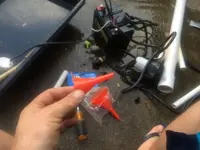
I used small funnels like in my video on the 1.5" one
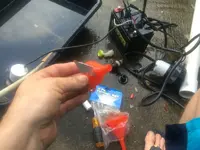
It can be easily cut with razor blade
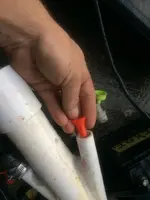
Cut it very snug fit
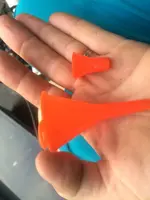
Here is one made and one not , i used cheep 4 piece funnel kit from family dollar for a 1$
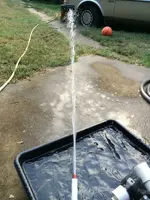
And here is test of one jet , 15 feet nice straight strong stream of water i like that
i like that

Look in how snug and tide the jet fits in the 3/4 " pvc , lets glue it
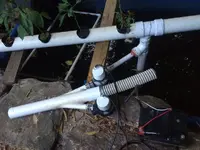
Ok i shorten the 2" pipe little on both ends
And shorten the suction hose also
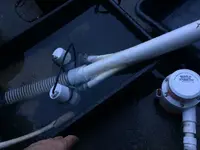
And it Sucks allot of suction , now i need time to make it to the creek
allot of suction , now i need time to make it to the creek 

I used small funnels like in my video on the 1.5" one

It can be easily cut with razor blade

Cut it very snug fit

Here is one made and one not , i used cheep 4 piece funnel kit from family dollar for a 1$


And here is test of one jet , 15 feet nice straight strong stream of water
 i like that
i like that 
Look in how snug and tide the jet fits in the 3/4 " pvc , lets glue it

Ok i shorten the 2" pipe little on both ends
And shorten the suction hose also

And it Sucks
 allot of suction , now i need time to make it to the creek
allot of suction , now i need time to make it to the creek 
Timberdoodle
Sr. Member
- Joined
- Oct 17, 2012
- Messages
- 316
- Reaction score
- 243
- Golden Thread
- 0
- Location
- Kingfield, Maine
- Primary Interest:
- All Treasure Hunting
Nice job djpitr! It's all about matching the best size orifice to the pressure available. You should also try that 3700 pump connected to both inputs with a slightly larger orifice for each jet. It's the pressure that induces the water speed of the jets and that speed entrains the suction fluid and once the energy is fully transferred in the jet it is converted back to pressure in the outlet flow. The overall induced pressure determines suction and lift characteristics. This is why you can never obtain much lift with a bilge pump jet even though you can obtain decent suction if you keep the lift close to water level or below.
djpitr
Full Member
- #20
Thread Owner
Nice job djpitr! It's all about matching the best size orifice to the pressure available. You should also try that 3700 pump connected to both inputs with a slightly larger orifice for each jet. It's the pressure that induces the water speed of the jets and that speed entrains the suction fluid and once the energy is fully transferred in the jet it is converted back to pressure in the outlet flow. The overall induced pressure determines suction and lift characteristics. This is why you can never obtain much lift with a bilge pump jet even though you can obtain decent suction if you keep the lift close to water level or below.
Thanks Timberdoodle
Tnet rocks , one can learn here alot .
Im planing to play with the big and heavy 3700 pump too and see what i can build with it

The only think is its really heavy , and uses 16A , thats allot .
I really just need as smaller and lighter so it can be easy put in back pack , just for cleaning crevices where i cannot fit my shovel .
Similar threads
- Replies
- 2
- Views
- 436
- Replies
- 11
- Views
- 513
Users who are viewing this thread
Total: 1 (members: 0, guests: 1)
Latest Discussions
-
-
Confederate Gold from the Civil War was Found in a Shocking Place
- Latest: Tesorodeoro
-
-
-
Naturallly Occuring Formation OR Manmade Treasure Marker/Sign?
- Latest: Crosse De Sign
-

